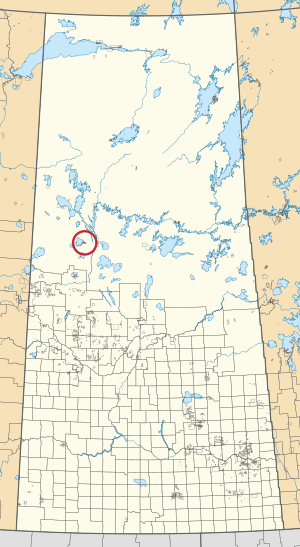Onikahp Sahghikansis 165E facts for kids
Quick facts for kids
Onikahp Sahghikansis 165E
|
|
|---|---|
| Onikahp Sahghikansis Indian Reserve No. 165E | |

Location in Saskatchewan
|
|
| First Nation | Canoe Lake |
| Country | Canada |
| Province | Saskatchewan |
| Area | |
| • Total | 1,503 ha (3,714 acre) |
Onikahp Sahghikansis 165E is a special area of land called an Indian reserve. It belongs to the Canoe Lake Cree First Nation in Saskatchewan, Canada. These reserves are lands set aside for the use and benefit of First Nations peoples.
Contents
What is Onikahp Sahghikansis 165E?
Onikahp Sahghikansis 165E is one of the lands that the Canoe Lake Cree First Nation calls home. It is a place where members of the First Nation can live and practice their traditions. This reserve helps keep their culture and community strong.
Location and Size
This reserve is located in the province of Saskatchewan. Saskatchewan is in the central part of Canada. You can see its location on the map in the infobox above. The total area of Onikahp Sahghikansis 165E is about 1,503 hectares. A hectare is a unit of area, and 1,503 hectares is roughly the size of 3,714 football fields!
Who are the Canoe Lake Cree First Nation?
The Canoe Lake Cree First Nation is an Indigenous group in Canada. They are part of the larger Cree nation. The Cree are one of the largest groups of First Nations in North America. They have a rich history and culture.
Their History and Culture
The Canoe Lake Cree have lived in the Saskatchewan area for a very long time. Their history is deeply connected to the land. They have traditional ways of life that include hunting, fishing, and trapping. Storytelling, ceremonies, and traditional arts are also very important to their culture. They work to pass these traditions down through generations.
Why are Reserves Important?
Indian reserves like Onikahp Sahghikansis 165E are very important for First Nations. They are places where communities can live together. They help preserve their unique cultures and languages. Reserves also allow First Nations to have a place to govern themselves.
Self-Governance and Community
First Nations on reserves have their own governments. They make decisions about their community's daily life. This includes things like education, health, and local services. This self-governance helps them build strong, independent communities. It also ensures their traditions and values are respected.

